Task Trainer/Partial Task Trainer (TT/PTT) Simulation includes the use of products to train or practice a specific skill such as intubation, central venous line placement, IV insertions, lumbar punctures, and other procedures. Learners can practice new skills or just refresh some skills they might not perform on a regular basis. TT/PTT can be used during a simulation or be setup for use in our spacious, state-of-the-art Procedural Skills area. Listed below are some of the task trainer/partial task trainers utilized at the CSC.
For questions, email clinicalsimcenter@stonybrookmedicine.edu.
Adult Airway Trainer
From the basics of ventilating a patient with a Bag Valve Mask (BVM) to more advanced techniques and procedures, our adult airway trainers allow learners to gain confidence in a variety of skills:
- Practicing of oral and nasal intubation
- Practicing use of LMA (Laryngeal Mask Airway) and Combitube
- Correct tube placement can be checked by practical inflation test
- Realistic anatomical features allow demonstration of Sellick Maneuver and laryngospasm
- Bag-Valve-Mask ventilation can be practiced
- Stomach inflation and vomiting situation can be simulated
- Provides visual inspection of lung expansion
- Provides auscultation of breath sounds
- Airway anatomical model is standard with each trainer
- The realistic anatomical features allow for demonstration of the Sellick Maneuver and laryngospasm.
- These trainers also allow for the use of both Direct Laryngoscopy and the use of Video Laryngoscopy.

Adult Lumbar Puncture (LP) Trainer
The Spinal Injection Simulator is a valuable training and teaching aid allowing realistic demonstration and practice of all spinal injections. Spinal injection techniques include spinal anesthesia, spinal tap, epidural analgesia, caudal analgesia, sacral nerve block, and lumbar sympathetic block. Careful duplication of the anatomy ensures proper resistance in needle puncture and accurate palpation reference points.
- The spinal column can be placed in sitting or lateral positions for injection practice.
- The L1 and L2 sections of the vertebral column are clearly visible.
- The functional portion of this injection model includes L3-L5 vertebrae, plus the sacrum and coccyx.
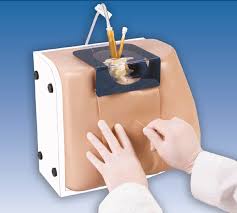
Arterial Puncture Arm
- Provides realistic practice for trainees
- Students can actually identify puncture locations through palpation of the pulse at either the radial or brachial sites
- Realistic arterial pressure produces a realistic backflow of blood in the syringe, confirming proper needle location in the artery
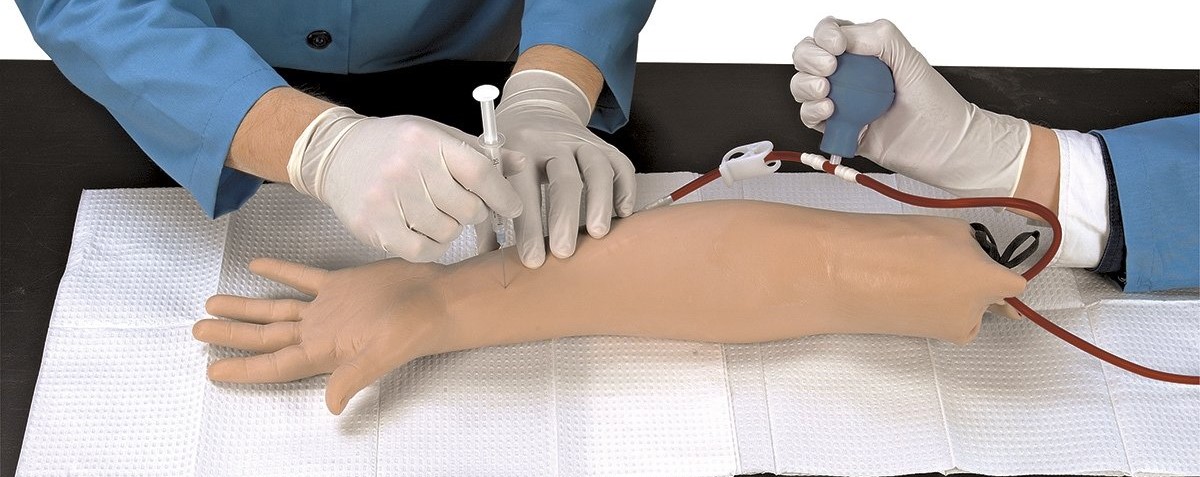
Birthing Task Trainer
Sophie and Sophie's Mum Birth Simulator is designed for the simulation of:
- Cephalic Birth
- Breech Birth
- Shoulder Dystocia
It is made from a highly realistic flesh-like material that creates an extremely realistic tactile experience when simulating birth. When used in conjunction with an SP, the Birth Simulator can enforce foundational clinical assessment and procedural skills and help to develop a learner’s interpersonal and communication skills, respectively. Simulating birth scenarios can help healthcare professionals recognize and potentially mitigate adverse events for new mothers and newborns.
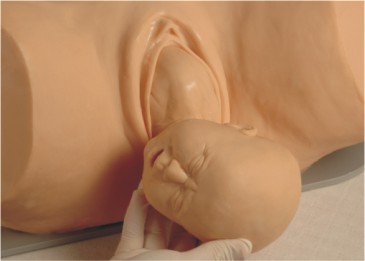
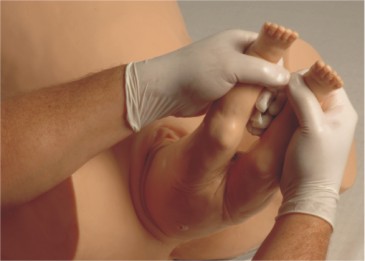

BLS Training - Adult CPR Manikin (with QCPR Feedback)
Our Laerdal Adult CPR manikin with QCPR Feedback meets the AHA Optimum Standard for Feedback.
Each manikin is equipped with a Blue Tooth Enabled Feedback measuring device providing real time measurements of compression depth, rate, recoil, and ventilations.
With this real time feedback, the learners are able to correct "on the fly" enabling better patient outcomes in the field.
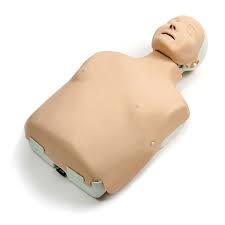
BLS Training - AED Trainer
2020 AHA BLS Guidelines compliant
- There are ten (10) pre-configured sudden cardiac arrest scenarios
- Offers all the essential features necessary for learning appropriate AED use and techniques
- Battery operated, delivering no energy to the pads for safe and effective learning
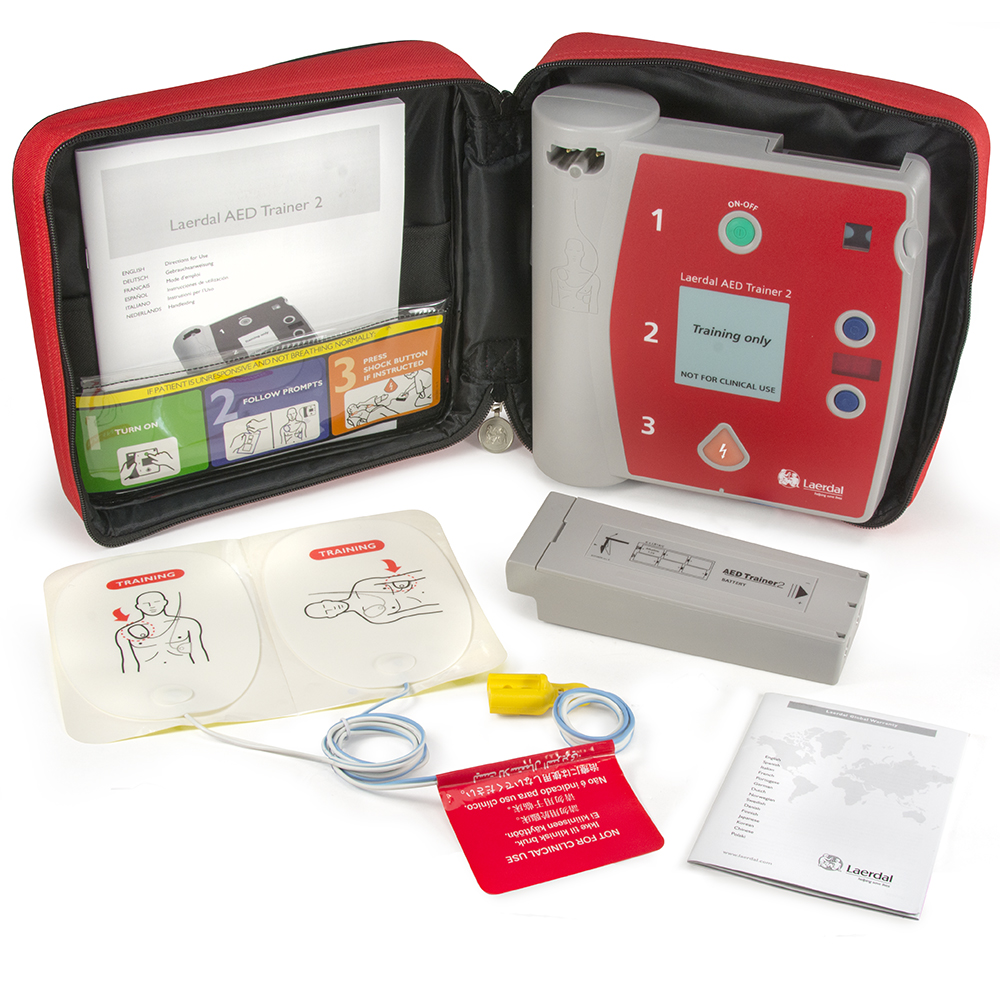
BLS Training - Infant CPR Manikin
Natural obstruction of the airway allows learners to learn the important technique of opening the airway.
Head tilt/chin lift and jaw thrust allow learners to practice correctly all maneuvers necessary when resuscitating a real patient.
Realistic chest compliance means learners can experience the proper technique required for chest compressions on infants.
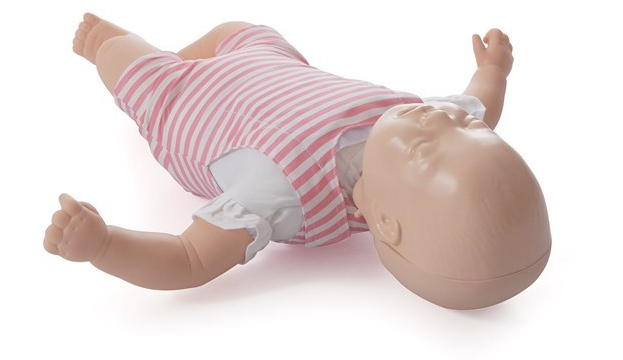
Central Line Trainer
CentraLineMan features clinically relevant landmarks and anatomy; learners can practice performing full venous catheterization using ultrasound guided or blind/landmark insertion approaches at the subclavian, and internal jugular vein sites.
This central line simulator includes clinically relevant internal and external landmarks that are palpable and or visible under ultrasound. These include:
- Upper torso and neck
- Trachea
- Clavicle
- Sternal notch
- Sternocleidomastoid muscle
- Sternal and clavicular heads of the sternocleidomastoid muscle
- Manubrium
- Lateral border of the first rib
- Superior vena cava
- Upper lung
- Vascular Anatomy including: External Jugular, Subclavian, and Brachiocephalic Veins; Carotid and Subclavian and Brachiocephalic Veins; Carotid and Subclavian Artery
Central Line Skill Development
- Practice full central venous catheterization using ultrasound guided or blind/landmark insertion approaches at the subclavian, supraclavicular, and internal jugular access sites
- Practice placing patient in appropriate position per access site standards
- Gain experience in identifying and selecting appropriate access site based on patient anatomical variations
Practice use of ultrasound for:
- Developing psychomotor skills required for obtaining visualization during cannulation
- Detecting anatomical variations
- Distinguishing vessels
- Visualizing arterial pulse and venous compression
- Identifying anatomical location of target vessel
- Visualizing needle cannulation of target vessel in transverse view
- Visualize threading of guidewire in longitudinal axis view
- Visualizing catheter placement
- Reducing rate of mechanical complications due to anatomical variances such as: pneumothorax or arterial puncture
- Improving first cannulation success and decreasing needle passes
Practice palpating external landmarks to identify vessel location and identifying unsuccessful vessel access by fluid feedback representing arterial puncture.
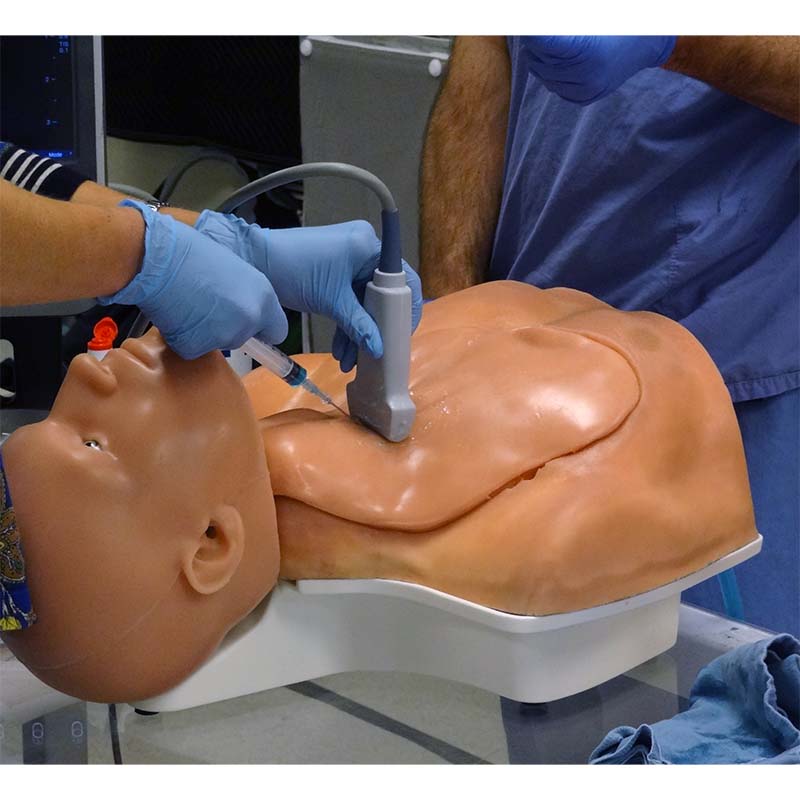
Chest Tube Insertion
Chest Tube Insertion trainer offers learners the opportunity to get the "first cut feel" on life like chest wall skin that bleeds from the initial incision. A realistic chest wall allows learners to palpate and find anatomic landmarks.
Chest tube insertion allows air or fluid trapped in the pleural space a one-way escape, allowing the lungs to expand and relieving pressure on the heart. A chest tube is also called chest drain, intercostal drain, pleural drain, tube thoracostomy or thoracic catheter.
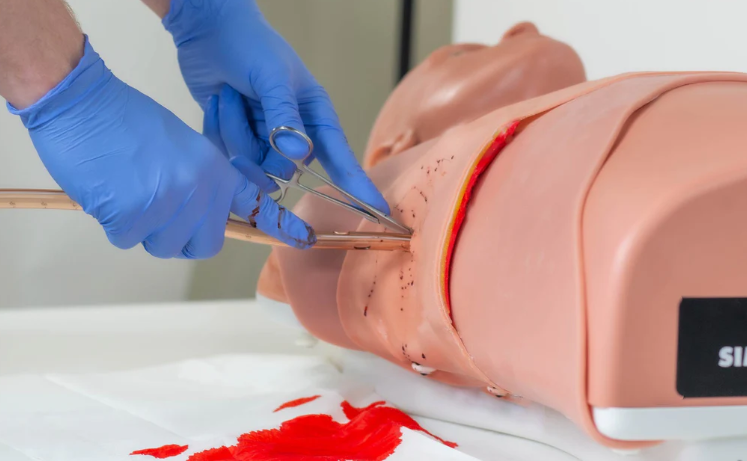
Clinical Female Pelvic Trainer
The Clinical Female Pelvic Trainer (CFPT) is an anatomically accurate and tactile representation of the female pelvis. It can help learners with the recognition of perineal and pelvic anatomy including bony landmarks. CFPT allows for digital vaginal examination, Bi-manual examination, cervical smear procedure (including use of speculum), and digital rectal examination.
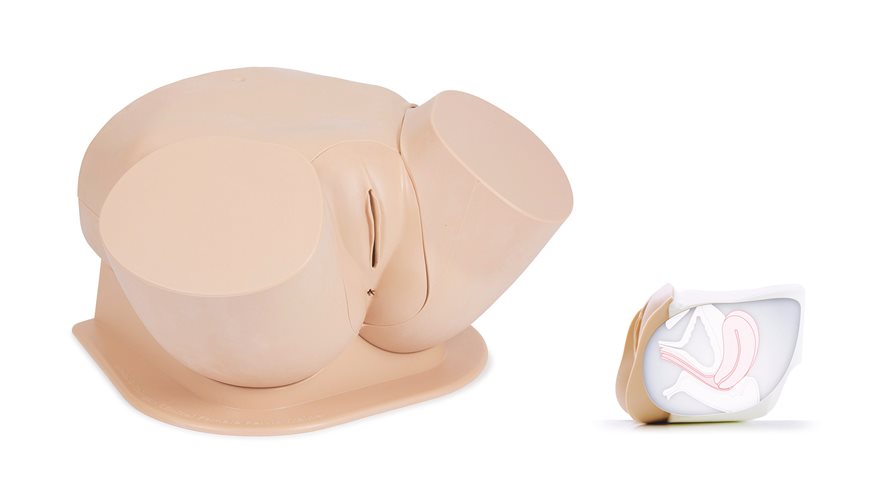
Cricothyrotomy Trainer
SimuCric Surgical Airway Training Simulator
- Needle and Surgical Cricothyroidotomy
- Percutaneous Tracheostomy
- Air Jet Ventilation
- Seldinger technique
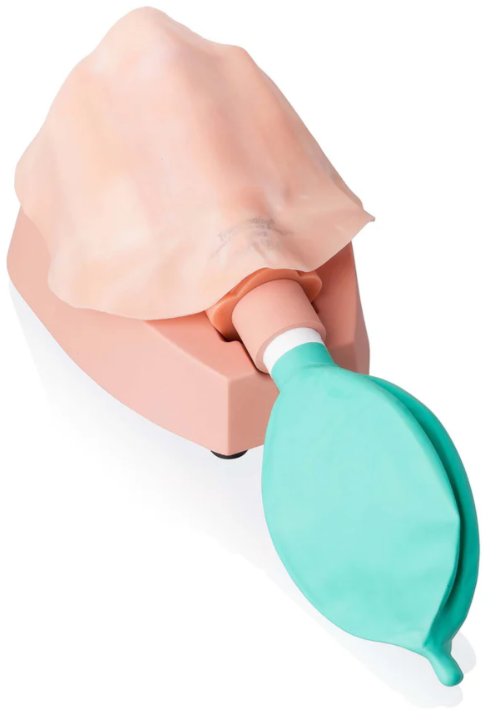
Episiotomy Repair Trainer
The Anatomy Lab Episiotomy Suturing Trainers are designed with life-like skin feel and response in accordance with accurate human anatomical structures. These educational simulators allow students learn proper surgical techniques by using realistic models. Models allow students to take their time to perfect their skills without the need of live patients. These trainers enable students to understand midline, left mediolateral, and right mediolateral episiotomy incisions and the practice of these specialized suturing skills.
This Training kit comes with 4 real-feel suture training models (1 normal perineum and 3 suturing) in a hard black carrying case.
Skills Gained
- Suturing on 3 kinds of incisions: Median episiotomy, left-lateral episiotomy, and right-lateral episiotomy
Features
- Anatomy: Precise anatomical structure - labium majora and labium minora, clitoris, vagina, anus
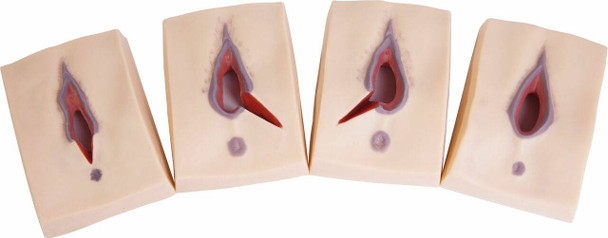

Femoral Line Trainer
Skill Development
- Practice the full vascular access procedure using the femoral vein under ultrasound guidance or blind/landmark insertion techniques
- Practice palpating external landmarks to identify vessel location
Practice use of ultrasound for:
- Developing psychomotor skills required for obtaining visualization during cannulation
- Visualizing arterial pulse and venous compression
- Identifying anatomical location of target vessel
- Visualizing needle cannulation, threading guidewire, and catheter placement
- Practicing femoral arterial puncture, catheter insertion or blind/landmark techniques
Features
- Anatomically correct, ultrasound compatible, body form, with all relevant palpating landmarks and vascular anatomy
- Market leading durability—self-sealing tissues and veins provide the greatest value, in frequency of needle sticks and full catheterizations per access site, of any trainer on the market
- Exceptional ultrasound imaging through repeated use—needle sticks and full catheterizations do not degrade the image acuity
- Two colors of simulated blood differentiate the arterial and venous vessels—provides immediate feedback of unsuccessful cannulation
- Arterial pulse is present and vein realistically compresses under palpation
- Easily adjustable venous pressure regulator allows for vein compression or low pressure simulation scenarios
- Replaceable tissues come pre-filled with blue venous and red arterial fluid
- Tissues can remain filled when not in use, and are easy to refill with provided fluid when necessary
- Portability—practice simulation in settings of actual patient care
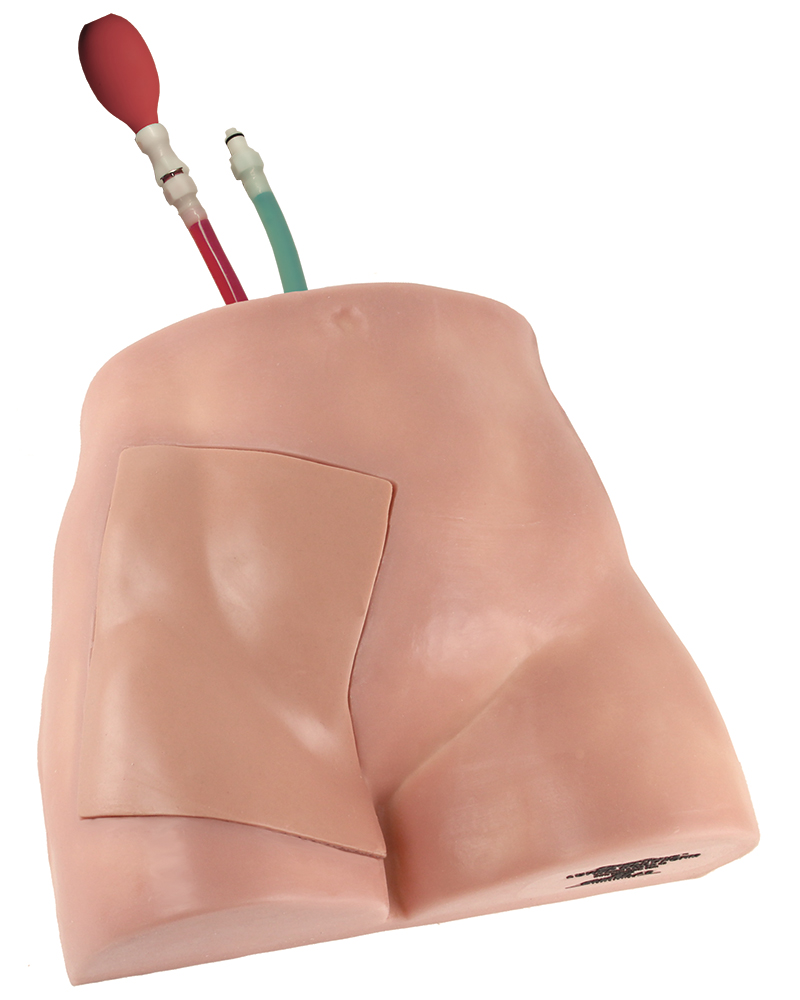
Foley Insertion Trainer
The Advanced Catheterization Trainer facilitates the teaching of urethral catheterization, as well as how to demonstrate self-catheterization to patients (when using the optional Self Catheterization Stand).
It has interchangeable accurate male and female anatomy, and both sets of genitalia are realistically soft and pliable. The feel of the catheter passing along the urethra into the bladder corresponds closely to real life.
Skills Gained
- Correct handling of male and female anatomy
- Aseptic catheterization technique
- Catheter placement: accepts catheters from 14-16 French (male) and 12-16 French (female)
- Fluid management
- Withdrawal of catheter
- Intermittent self-catheterization (ISC) when used with the optional Self-Catheterization Stand
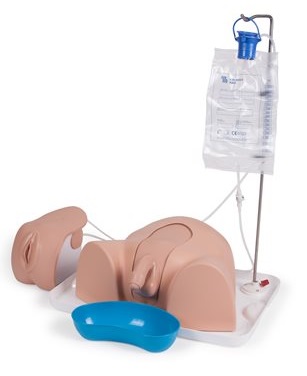
Task Trainer/Partial Task Name
Infant Airway Trainer
Realistic practice is the key to developing proficiency in airway management skills. The Laerdal Infant Airway Management Trainer provides the realistic anatomy of a three-month-old infant for teaching and practicing basic and advanced airway management skills.
Product benefits:
- Realistic representation of human anatomy, tissue, and skin material
- Allows students to undertake training that is directly transferable to the clinical setting
- Minimal maintenance and robust design enable cost effective training
- A base plate mount allows stable practicing conditions and easy transportation
- The cover prevents dust from coming into contact with the head during storage
Product features:
- Realistic anatomy of the tongue, oropharynx, epiglottis, larynx, vocal cords, and trachea
- Practicing of oral and nasal intubation
- Practicing use of LMA (Laryngeal Mask Airway)
- Correct tube placement can be checked by practical inflation test
- Bag-Valve-Mask ventilation can be practiced
- Sellick Maneuver can be performed
- Stomach inflation
- Realistic tissue simulation
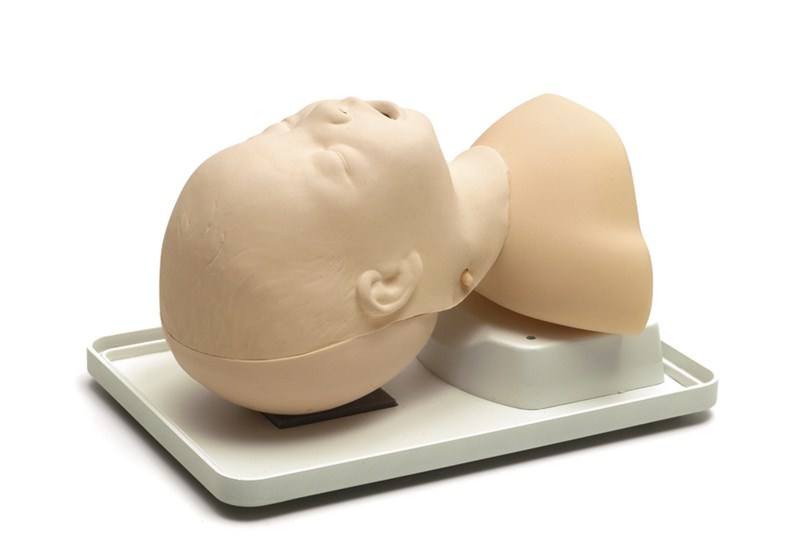
IO Trainer
A valuable addition to life-saving technology in emergency medicine. It enables safe and fast application of intraosseous access. The EZ-IO® Bone Drill provides healthcare professionals with immediate vascular access to the central circulation within seconds. This enables the delivery of intravenous fluids to adult and paediatric patients. The Bone Drill provides complete control of needle guidance without the use of force. The EZ-IO® training set helps healthcare professionals learn how to use bone drills and needles safely.
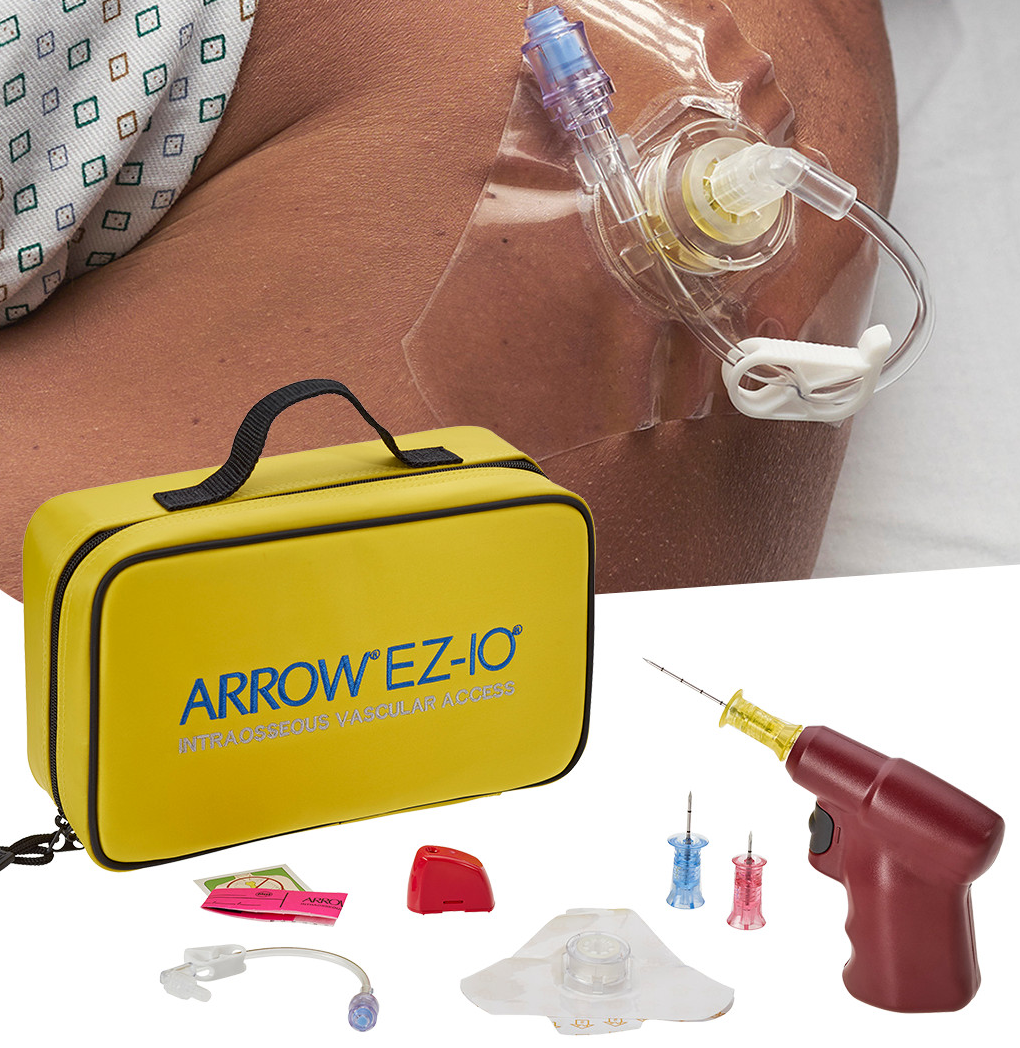
IV Insertion Arm
Establishing venous access is imperative to patient care. Our IV Training Arms allow learners to become proficient in this skill, thereby reducing stress to themselves and more importantly to the patient.
Some features of our IV Training Arms are:
- Realistic blood flashback
- Arm allows for digital pressure to stem blood flow
- Infusion Tube allows for volume IV fluids to be administered
- Can be used with vacuum blood collection systems, needle and syringe and IV cannulas
- Can be used for hybrid simulation and for professional-to-patient communication when using the optional Venipuncture Arm Harness
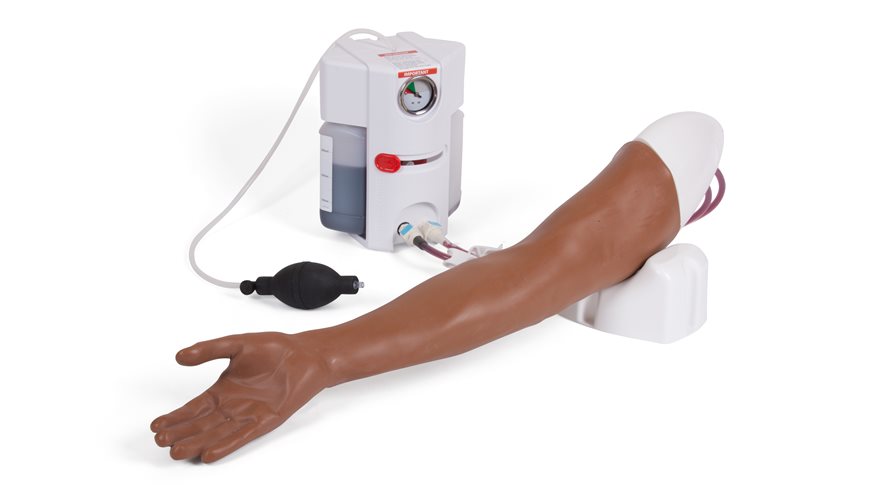
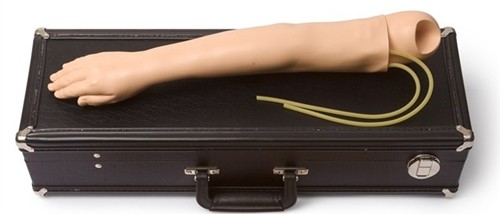
Midline Insertion
The training simulator allows medical professionals to train using real-time ultrasound guidance during catheter placement. Practice the complete midline insertion procedure, including guidewire insertion, dilation, and full cannulation.
- Excellent for ultrasound-guided peripheral venous access hands-on training
- Anatomically correct human torso and partial right arm at 90-degree angle with landmarks
- Differentiate arterial and venous blood to present positive or negative results
- Positive flashback of simulated blood upon successful venous access
- Median Nerve is visible under ultrasound and adds realism in brachial vein access
- Arterial pulse and proper landmarks are present under real-time ultrasound to help avoid and detect errors
Palpable Landmarks
- Antecubital Fossa
- Clavicle
- Sternum
- 1st-4th intercostal space
- Acromion
- Ribs 1-7
- Humeral Head
Ultrasound Anatomy
- Basilic Vein
- Brachial Vein
- Cephalic Vein
- Median Nerve
- Brachial Artery
- Humerus
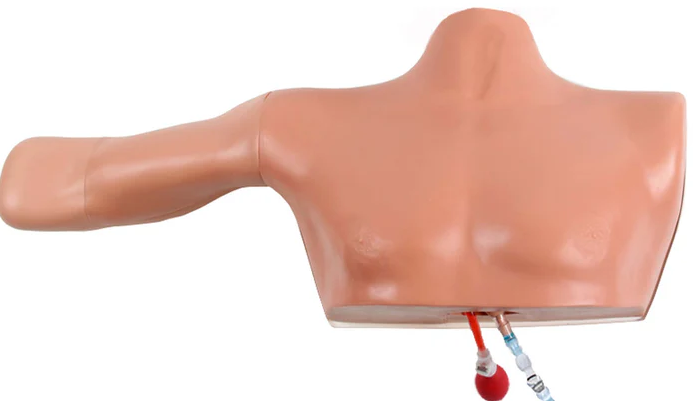
Pediatric Lumbar Puncture (LP) Trainer
Infants commonly require lumbar puncture as a diagnostic procedure used to collect a sample of cerebrospinal fluid (CSF), measure cerebrospinal fluid pressure, or to inject medications intrathecally. The Pediatric Lumbar Puncture Simulator represents a 10–12-month-old infant placed in a left lateral decubitus position with the neck and knees flexed, approximating the necessary fetal position. The embedded iliac crest offers exceptional realism, while the removable spine, spinal canal and skin pad make training simple and hassle free. Lumbar puncture may be performed in the L3-L4, L4-L5, or L5-S1 spaces. The correct site can be located by palpating the iliac crest and spine. A small give" will be felt as the spinal needle is advanced slowly into the proper space. Fluid will flow when the needle is in proper position. Students will appreciate the opportunity to practice this delicate but commonly performed procedure on a simulator that is both appealing and anatomically accurate.
Benefits:
- Targets key skills specific to pediatric lumbar puncture procedures
- Palpation of landmarks
- Skin preparation
- Needle positioning and insertion
- Cerebrospinal fluid collection
- Measure cerebrospinal fluid pressure
- Intrathecal injections
Features:
- Anatomically correct and palpable
- Correct body positioning
- Realistic resistance
- Simulated CSF flows with successful puncture
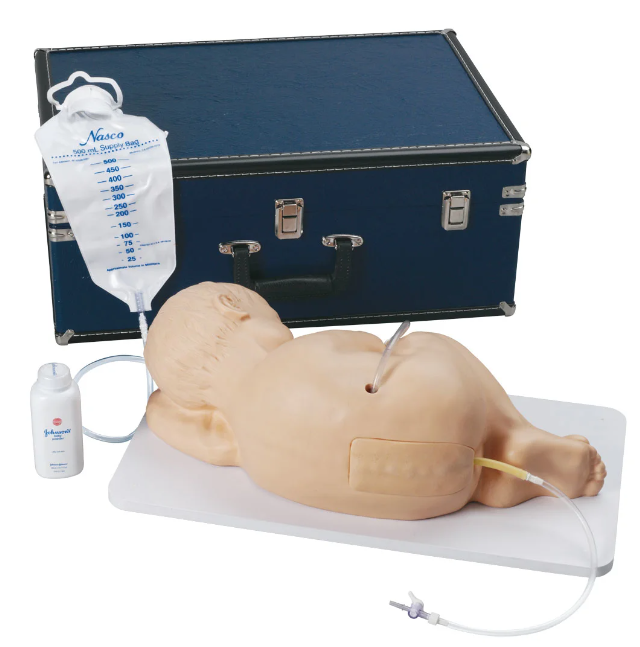
Ultrasound - Blue Phantom Trainer
Phantom training is an excellent way to develop, practice and maintain ultrasound skills. The Blue Phantom Select Series Branched 4 Vessel model is one of the most realistic training phantoms on the market. It provides an excellent opportunity for clinicians to create their training scenario by creating 3D branching for up to 4 vessels. This compact ultrasound training model is ideal for beginners and skilled clinicians aiming to learn more complex insertion techniques. In addition, it is incredibly durable and reusable, thanks to Blue Phantom's proprietary synthetic tissue construction of the Block. In sum, the 4-Vessel Training Block is a cost-effective ultrasound training model for clinics and hospitals.
Features:
- Lightweight and compact design.
- Blue Phantom's patented lifelike replicated human tissue provides an authentic experience for practitioners.
- The training bloc features four vessels of varying sizes.
- Easy refilling and fluid injection
- Helps learn ultrasound imagining, system controls, and techniques used in venepuncture
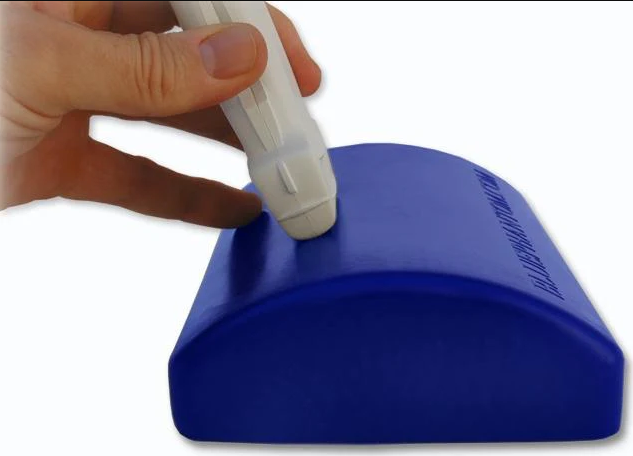
PacerMan Trainer
PacerMan System is the first and only high-fidelity simulator for immersive transvenous pacing training—from needle insertion to electrical capture using all the clinical equipment. With PacerMan, clinicians can practice the entire procedure—including identifying intrinsic bradycardias, assessing intracardiac waveforms and manipulating output and rate with a pacing generator.
Features:
- Durable replaceable tissue for full catheterization using an introducer and temporary pacing lead
- Ultrasound-guided venous identification and access with fluid aspiration
- Randomized Student and Instructor Modes with multiple outcome options
- Simulated Patient Monitor with: Real-time vitals including heart rate, arterial blood pressure, non-invasive blood pressure, and oxygen saturation.
- Simulated defibrillator for transcutaneous pacing and transition of care
- ECG tracing that presents intracardiac location waveforms representing the Superior Vena Cava, Right Atrium, Right Ventricle, Inferior Vena Cava, Pulmonary Artery and Current of Injury Pattern.
Skills:
- Learn to manipulate the pacing generator and interact with a transvenous pacing catheter and introducer kit. – Not included
- Obtain electrical capture
- Refine amperage of electrical output and pulse rate in real time.
- Improve procedural performance through instructor-led pre-defined competencies or self-directed practice
- Practice medical decision-making based on outcome options
- Train using blind and ECG guided techniques
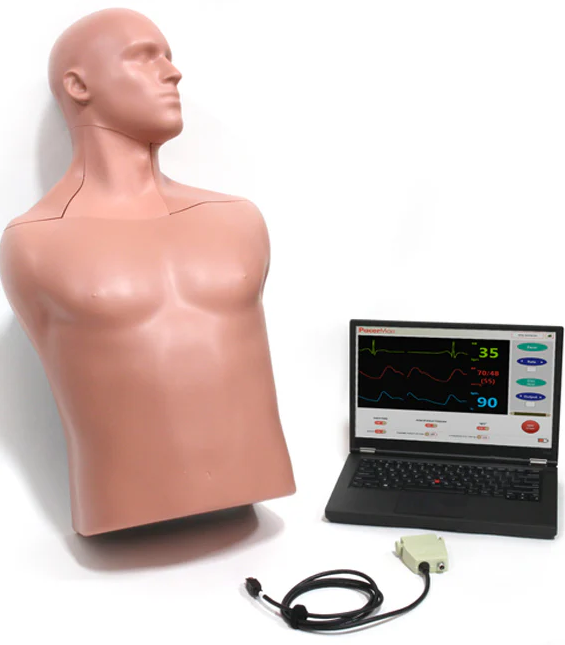
Task Trainer/Partial Task Name

